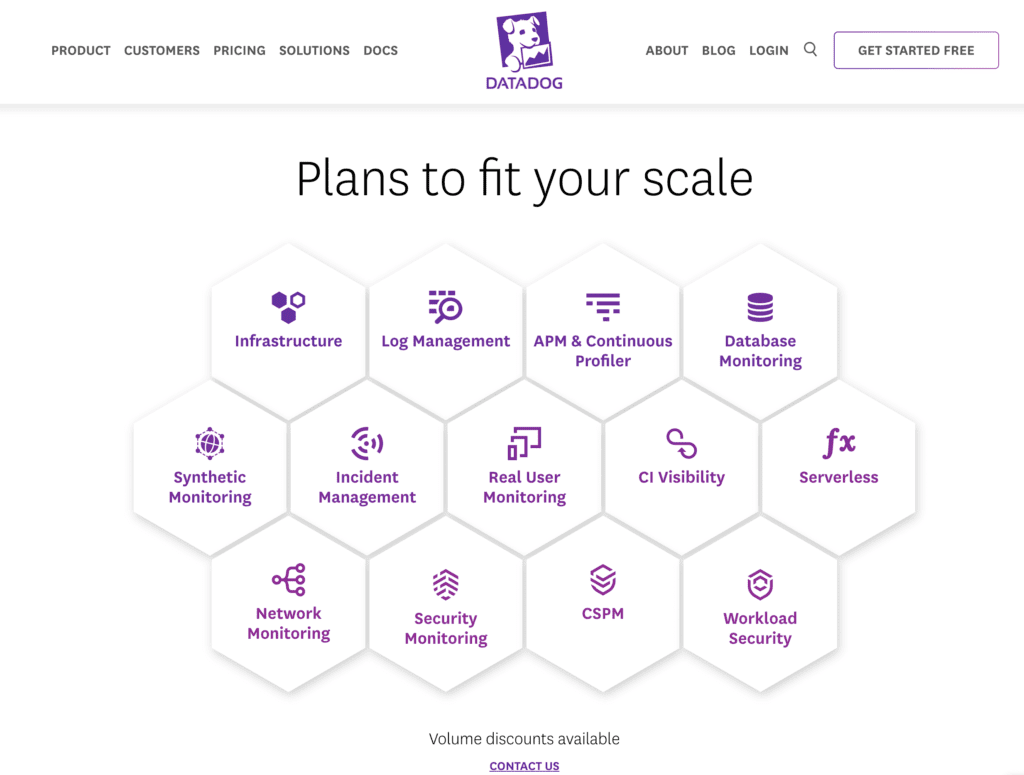The more established your brand, the more complex your pricing page can be
Because then, it becomes about what to buy — not from whom pic.twitter.com/1ag8jyPkmH
— Jason
BeKind
Lemkin
(@jasonlk) October 27, 2021
What makes for a good pricing page? It’s a challenging question because most of us don’t have the volume to really do A/B tests (although try of course). We have to at least start by copying best practices from the leaders.
A few thoughts at least — mainly about what to copy from the big leaders, and what to maybe not copy from them:
- The stronger the brand, the more complex the pricing page can be. So yes, copy Salesforce, Twilio, Slack, Datadog, and other iconic leaders on many things. But bear in mind their brands make them a default choice. That means their prospects will be more patient with complex pricing. And very importantly, prospects with the top brands often use pricing pages to decide what to buy — not if and from whom. You aren’t there yet. Your prospects may just move on if the pricing page makes it seem too … hard.

- Familiarity in your pricing schema is key to maximizing sales velocities with less well-known vendors. Innovation is great … just often not on pricing. At least not in the early days. Prospects need context. Copy someone’s pricing page and style that your prospects often already have purchased. That will give them context.
- “Editions” are super helpful when you sell to customers of varying sizes (i.e., S, M and L). Big companies intuitively know they “want” the Enterprise Edition. So add one. We’ve all bought 50–100+ apps now. We know which segment we are in at this point, more or less:
- Be thoughtful on non-transparent pricing. It works, but it also has significant costs, especially outside the largest customers. Yes, “Contact Me” can work well in the enterprise and for larger deals. But it will turn off many smaller prospects. Err on the side of transparent pricing, at least until you have experience and data to suggest you should move away from it. 90% of the time, transparent pricing just takes friction out of a transactional / shorter sales process. Or put differently, perhaps use transactional pricing for any customer segment than can close in 30 days or less. More here: Turns Out, 85% of the World Likes “Contact Me”. Even Though You Don’t. | SaaStr
- It’s OK to leave money on the table in the early days. In the early days, you want to close every possible lead. Later, what will matter more is closing the most revenue from the leads you do have. Those imply very different strategies.
- Anchoring high works, but you have to go all-in to make it work. Pricing is a message, and if you price at the highest end of your competition and segment, that will send a message you are the most valuable vendor. It may well be easier to close large customers if you are the most expensive vendor in the space. But if you choose this strategy, you have to go all in. You have to truly be the most secure, the most redundant, the best integrated, the most enterprise vendor. You also need enterprise-grade approaches to customer success and deployment. So Anchor High if you can deliver. It can be the fastest way to increase revenue 50%-100% or more, if you can pull it off. But you can’t go half-in here. More here.
- With bigger customers, it’s total deal size that matters. If you can simplify this calculation (like Slack and Atlassian do), it can help. Bigger customers really want to know what it will cost to deploy you to their division, their team, their org etc.
- No one wants to get ripped off. Especially now that we’re all SaaS buying veterans. This is maybe the most important thing to think about in the end. To have happy customers that spread your brand through word-of-mouth:
- Pricing should seem fair.
- There should be pricing protection for renewals and later years.
- Upsell should be as organic as possible.
- Concerns should be addressed, and support should be as close to real-time as practical.
- Finally, remember what really really matters is CLTV. The total lifetime value of the customer. And customers in SaaS can last decades. Think more about how to naturally grow the account over the years to come. And a little less about how to get every nickel on Day 1. A bit more on that here.
(note: an updated SaaStr Classic post)
The post 9 Thoughts on What Makes For a Good Pricing Page appeared first on SaaStr.
via https://www.aiupnow.com
Jason Lemkin, Khareem Sudlow
